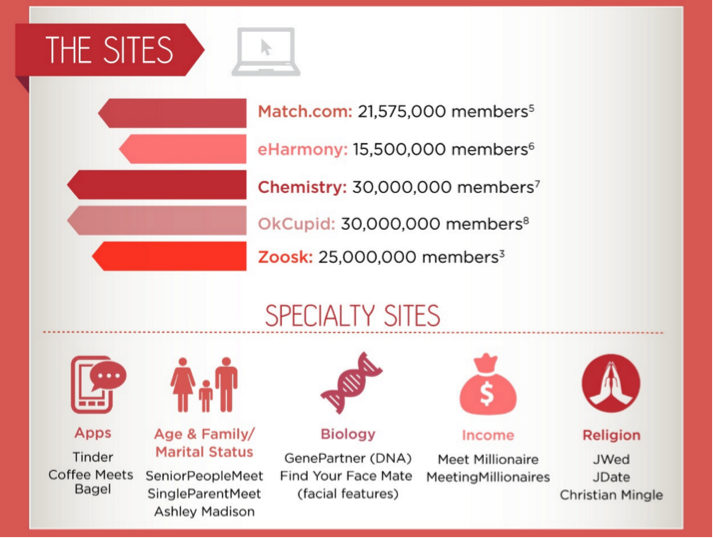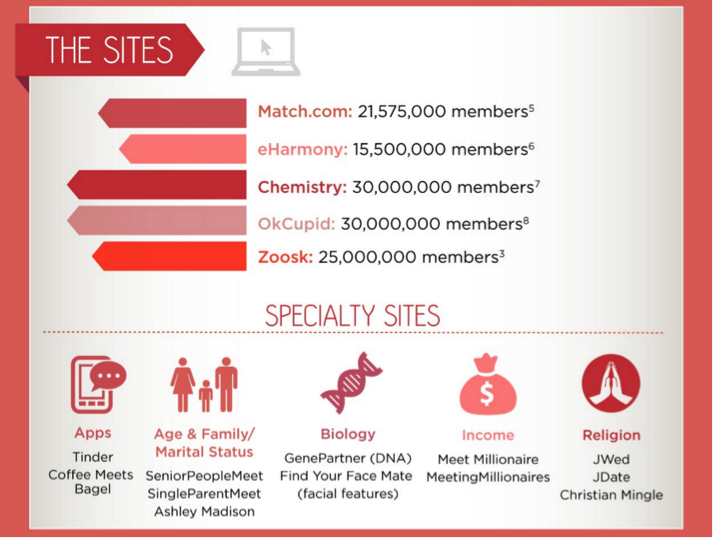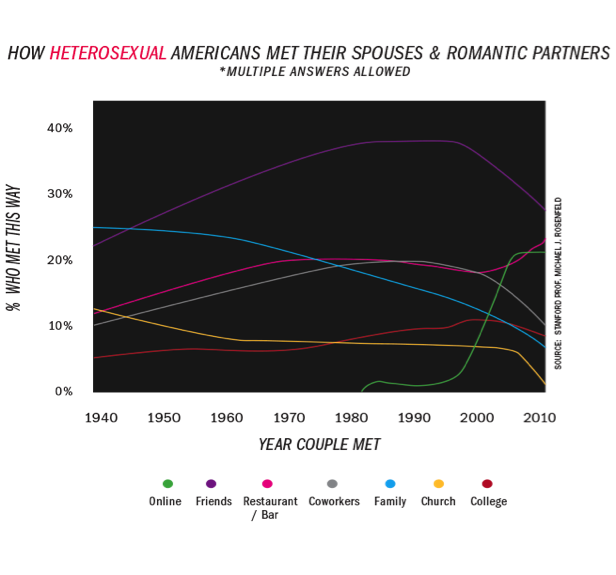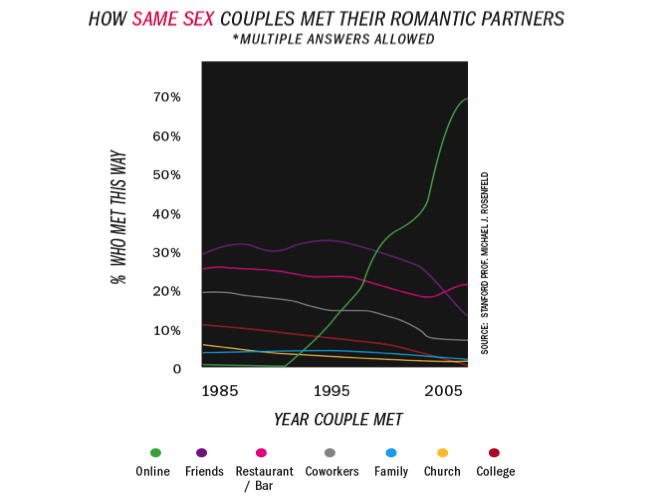
Sex is one of the most powerful, fundamental human drives.
It's caused wars… built and destroyed kingdoms.
It occupies a significant percentage of most people's thoughts.
As such, it's worth a conversation about how exponential technologies will change our relationship with sex.
This blog (Part 1 of 2) is a look at the future of sex, dating, and finding a mate. Next week, in Part 2, we'll dive one level deeper and discuss the future of human reproduction.
P.S. Send any tips to our team by clicking here, and send your friends and family to this link to subscribe to Abundance Insider.
Dating in the Internet Age
Dating in past generations was local and linear. You had access to a small number of potential mates based on where you lived, where you went to school and your social status.
In the 1960s, over 50% of marriages globally and 95% of marriages in India were arranged.
Today that number has dropped to less than 15% (globally).
In 1960, the median age at first marriage for the bride was 20 and the groom was 23 years old.
Today, the median age is closer to 29 for women and 30 for men.
A cultural shift is happening, and it's changing the game.
Dating has gone digital. As such, it has gone from local and linear to global and exponential.
Today, 40 million Americans use online dating services (that's about 40% of the single population in the U.S.), driving the creation of a $2.4 billion online dating industry.

(Number of members of online dating platforms, 2014)
These services transcend geography and social strata. People are matched from around the world.
Between 1995 and 2005, there was exponential growth among heterosexual couples meeting online. (See the green line in the chart below.) (Heterosexual marriage trends over time)
(Heterosexual marriage trends over time)
For same-sex couples, the online dating trend has been even more dramatic, with more than 60% of same-sex couples meeting online in 2008 and 2009 (see the green line in the chart above).

(Same-Sex Couples – trends over time)
The implications of this are staggering -- besides moving the marriage age back, there are a number of sociological effects such as decision fatigue, gamification of dating, and the commoditization of people that will start to have population-level effects as mating behaviors change.
And this is just the beginning.
Dating & Exponential Tech
In the very near future, we will see machine learning / artificial intelligence-based matchmakers that will find the perfect match for you based upon everything from your genomics to your psychographics.
Once you're on a date, your augmented reality glasses will give you real-time dating info, calling up any info you want to know, as you need to know it.
Perhaps you want to understand how she/he is feeling about you, and your AR camera is watching her pupillary dilation and capillary flushing.
Like all technology, these applications are double-edged swords. My hope is that this tech actually increases the number of successful, meaningful relationships in the world and, in turn, has a net positive impact.
But while dating is one side of the coin, sex is another... and the implications of exponential technology on sex can be shocking.
Sex & Exponential Tech
Today, sex has been digitized; as such, it has been dematerialized, demonetized and democratized.
Sex, in the form of pornography, is free, available to anyone with an Internet connection and pervasive across many platforms.
In 2015, just one pornography website reported that their users watched over 4.3 billion hours of porn (87 billion videos) that year.
The proliferation of Internet connectivity, online video players and streaming, mobile phones, and advertisement delivery networks have propelled pornography into a $97 billion industry.
This is causing a number of negative social phenomena.
More than half of boys and nearly a third of girls see their first pornographic images before they turn 13. In a survey of hundreds of college students, 93% of boys and 62% of girls said they were exposed to pornography before they turned 18.
"Pornography is influencing everything from how teens language and frame sexuality to how and why they pierce certain body parts to what they expect to give and receive in intimate relationships," says Jill Manning, Ph.D, Witherspoon Institute.
In Japan, a growing population of men report that they *prefer* having "virtual girlfriends" over real ones (i.e. they believe they are "dating" virtual avatars that they largely control).
Forty-five percent of Japanese single women and 25 percent of Japanese single men aged 16 to 24 claim they aren't even interested in sexual contact.
Given these trends, unless something happens to boost Japan's birth rate, its population will shrink by a third between now and 2060. In other words, there is serious concern of significant UNDERpopulation.
But again, this is only the beginning… as virtual reality (VR) becomes more widespread, one major application will inevitably be VR porn.
It will be much more intense, vivid, and addictive -- and as AI comes online, I believe there will be a proliferation in AI-powered avatar and robotic relationships, similar to those characters depicted in the movies Her and Ex Machina.
Implications
VR porn promises to offer a virtual world filled with more sex, better sex, endless sex, and new varieties of sex.
The dark secret, however, is that the further a user goes into that fantasy world, the more likely their reality is to become just the opposite.
Many psychologists believe that VR porn may numb us to sexual desire and pleasure in the real world, leading to less and less satisfying sex.
For many, VR (as well as other exponential technologies such as robotics, sensors and Artificial Intelligence.) will act as a complete replacement for intimacy and human relationships, as it is more easily accessible, cheaper, on-demand, and, well, controllable.
As the father of two five-year-old boys, this is really concerning to me...
That said, are there upsides too?
Perhaps a bit of intimacy (if even technological) for those who are infirmed, aged, crippled and thereby alone.
We shall see. One thing is for sure: as with every technology in history, from the printing press to VHS and the Internet, pornography will be on the front line funding the advance of technology.
Join Me
This is the sort of conversation we explore at my 250-person executive mastermind group called Abundance 360.
The program is highly selective. If you'd like to be considered, apply here. Share this with your friends, especially if they are interested in any of the areas outlined above.
P.S. Every week I send out a "Tech Blog" like this one. If you want to sign up, subscribe here for this and Abundance Insider.
P.P.S. My dear friend Dan Sullivan and I have a podcast called Exponential Wisdom. Our conversations focus on the exponential technologies creating abundance, the human-technology collaboration, and entrepreneurship. Head over here to listen and subscribe.







